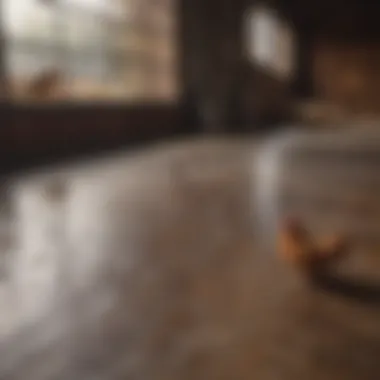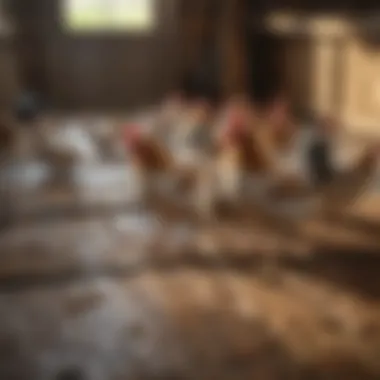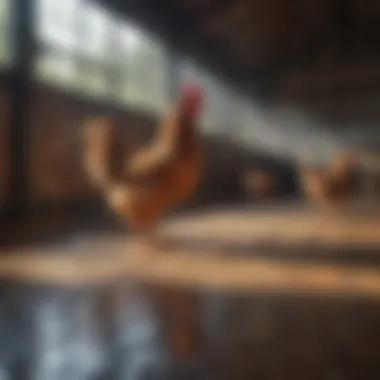Exploring Coop Flooring Options for Optimal Poultry Care


Intro
Poultry management is a cornerstone of agricultural practice. As modern farming faces numerous challenges, the role of coop flooring becomes increasingly critical in maintaining bird health and boosting productivity. Choosing the right flooring material can not only influence the welfare of the birds but also can significantly affect the overall efficiency of poultry operations.
With an array of options available, understanding the pros and cons of each type of flooring will empower farmers and enthusiasts in making informed decisions. This examination aims to dissect various flooring options, recognizing the need for sustainable practices that can cater to both the birds and the environment. The narrative will also shed light on innovative designs and practices that maximize effectiveness in coop management.
Understanding Coop Flooring
Coop flooring is not just a structural element; it’s a pivotal part of poultry management. The flooring system in a coop affects not only the health and productivity of the birds but also the comfort and safety of their environment. Understanding coop flooring opens the door to making informed decisions that enhance the overall welfare of poultry.
A well-thought-out flooring choice can minimize stress for the birds, prevent the spread of pathogens, and promote efficient farm management. It’s surprising to realize how much of a difference the ground beneath their feet can have on the overall farming operation.
Definition and Purpose
At its core, coop flooring can be defined as the surface material that lines the interior of a poultry house. Its primary purpose is to provide a safe, clean, and comfortable space for birds to roam, rest, and interact. The flooring can be made from various materials, each serving distinct goals in terms of comfort, hygiene, and durability.
For instance, natural materials, like straw and wood shavings, offer a soft surface that's good for the birds' feet, but they may require more frequent maintenance. Conversely, synthetics such as rubber mats and concrete might offer ease of cleaning and longevity, though they can lack in comfort. Knowing these definitions and purposes helps in making a smart choice that aligns with one's management goals.
Importance in Poultry Management
The flooring system within a coop is of utmost importance for several reasons:
- Health Benefits: Proper flooring can significantly reduce the risk of diseases by minimizing contact with droppings and damp conditions that promote pathogens. A well-chosen floor can absorb moisture and help control bacteria, keeping birds healthier overall.
- Behavioral Impacts: The type of floor can influence how poultry behave. For instance, a softer, more cushioned surface can lead to reduced stress and more natural behaviors, like scratching and pecking, which are crucial for their wellbeing.
- Operational Efficiency: Choosing the right flooring not only affects bird health but also eases the labor burden for farmers. Floors that are easier to clean and maintain save time and effort during routine management tasks, ensuring the farmers can focus on overall production goals.
"The choice of flooring can make a world of difference in productivity and bird welfare." - Poultry Management Journal
From reducing pathogen exposure to creating a more interactive environment for the birds, understanding coop flooring is fundamental for anyone involved in poultry management. It highlights the seamless connection between animal welfare and farming efficiency, urging farmers to look beyond aesthetics and consider the real impacts of their flooring choices.
Types of Coop Flooring Materials
The selection of flooring materials in poultry coops is more than just a matter of aesthetics; it directly affects the welfare, productivity, and overall health of the birds. Choosing the right flooring material can create a favorable environment for poultry, supporting their well-being and ensuring efficient management practices. A variety of flooring materials are available, each with its own set of characteristics, advantages, and challenges.
Natural Materials
Natural materials have been employed in poultry management for generations. They embody a variety of benefits that come from nature, making them a common choice among farmers looking for cost-effective and sustainable solutions. Let's take a closer look at some key natural options.
Straw
Straw is often favored due to its affordability and availability. This material provides a soft bedding for the birds, which is crucial for their comfort and well-being. Straw also acts as a natural insulator, helping maintain a stable microclimate inside the coop. However, it has its drawbacks; if not managed properly, straw can accumulate moisture, leading to bacterial growth. This can pose health risks to the birds, making regular changing of bedding essential.
Key Characteristics of Straw:
- Affordable and widely available
- Provides good insulation
- Requires regular maintenance to prevent moisture buildup
Advantages and Disadvantages:
The main advantage of straw is its softness and insulation. Yet, its tendency to harbor bacteria if not maintained properly is a significant disadvantage that must be addressed to ensure flock health.
Wood Shavings
Wood shavings stand out due to their absorbent qualities. They have an excellent capacity to soak up moisture, keeping the coop drier and reducing the risk of disease. Farmers often admire wood shavings because they also produce less dust compared to straw, making them easier on the respiratory systems of both humans and birds. On the flip side, wood shavings can be a bit more expensive than straw, and certain types can carry oils that may irritate the birds' skin or respiratory tracts.
Key Characteristics of Wood Shavings:
- Highly absorbent
- Less dusty than straw
- Costlier than some other options
Advantages and Disadvantages:
The absorbency of wood shavings is a definite strength, which helps maintain a healthier environment. However, the cost must be weighed against other budget factors when making flooring choices.
Sand
Sand is becoming a popular flooring material as well. It offers many advantages, such as excellent drainage, which helps eliminate moisture issues. The birds can scratch and dig in the sand, which satisfies their natural instincts while also promoting foot health. Nevertheless, sand can be heavy and may need regular replenishment to maintain a suitable depth in the coop.
Key Characteristics of Sand:
- Excellent drainage capabilities
- Encourages natural behaviors in birds
- Heavier than alternative materials
Advantages and Disadvantages:
Sand’s drainage ability is highly beneficial, allowing for a dry and clean environment. However, the initial weight and cost can be potential drawbacks that need considering.
Synthetic Materials
As poultry management evolves, many producers are turning to synthetic materials to gain specific advantages. These flooring options often require less frequent replacements and can address some drawbacks inherent in natural materials.
Plastic


Plastic flooring is known for its durability and ease of cleaning. It can be an ideal choice for commercial operations, where efficiency is key. Plastic surfaces are usually non-absorbent, which helps prevent bacteria growth. However, they can become slippery, potentially posing a risk for birds' foot health.
Key Characteristics of Plastic:
- Durable and long-lasting
- Easy to clean, reducing labor time
Advantages and Disadvantages:
Plastic's longevity and cleanliness are incredible benefits. However, farmers must take precautions to ensure the flooring is not too slippery.
Rubber Mats
Rubber mats are emerging as a flexible choice for coop flooring. They provide cushioning for the birds, lessening the risk of injuries from slipping or falling. Rubber's non-slip properties are valuable, though it can trap moisture if not appropriately managed. Additionally, these mats may carry a higher initial cost compared to other materials.
Key Characteristics of Rubber Mats:
- Soft and safety-oriented
- Non-slip surface beneficial for bird mobility
Advantages and Disadvantages:
Their cushioning effect is highly advantageous for bird well-being. However, rubber mats require careful maintenance to avoid moisture-related issues.
Concrete
Concrete flooring has a reputation for being sturdy and long-lasting. It is resistant to pests and doesn't absorb odors. One significant drawback is the coldness of the surface, which can be uncomfortable for the birds. If not maintained, concrete can also become porous over time, potentially allowing bacteria to thrive.
Key Characteristics of Concrete:
- Sturdy and long-lasting
- Resistant to pests and odors
Advantages and Disadvantages:
Concrete's durability and pest resistance are notable benefits, but ensuring it remains comfortable for the birds is a vital consideration in its usage.
Advantages of Various Flooring Options
When it comes to poultry management, selecting the right flooring isn't just a trivial decision—it's foundational to the health and productivity of your flock. Each flooring material possesses its own array of characteristics that can impact not just the chickens themselves, but also the overall efficiency of the poultry operation. Understanding these advantages allows farmers and poultry enthusiasts alike to make informed choices tailored to their specific needs.
Durability
Durability in coop flooring refers to the ability of the material to withstand the wear and tear from heavy foot traffic, waste, and environmental elements. Selecting flooring that can endure the daily rigors of chicken life can save time and money in the long run. For instance, concrete flooring, while rigid and cold, offers longevity that other materials may not. It resists moisture damage and is less susceptible to pests and pathogens. On the other hand, while straw provides a great natural covering, it may need to be replaced more often than more robust options. The right choice hinges on balancing durability with animal comfort.
Ease of Cleaning
The ease of cleaning is another crucial factor to consider. Flooring that allows for quick and efficient cleaning saves time, reduces labor costs, and enhances overall flock health. For example, rubber mats provide a cushioned surface that not only absorbs shock but also facilitates easier washing compared to more porous materials like wood shavings. Moisture retention in wood can lead to mold, which poses a significant health risk. Providing a clean environment directly correlates with lowering the risk of disease, making cleanliness a top priority for any poultry operation.
"A clean coop is a happy coop." This is not just a saying; it has real implications for productivity and bird wellbeing.
Cost-Effectiveness
Cost-effectiveness encompasses not only the initial investment but also ongoing maintenance and replacement costs. While some flooring options like natural straw are cheaper upfront, they may incur higher recurring expenses due to replacement needs. In contrast, synthetic materials like plastic or rubber mats, though initially higher priced, often pay off over their lifespan through minimal maintenance costs and extended durability. Understanding the long-term financial implications of each type is essential. Keeping an eye on the return on investment helps farmers make smarter choices for their operations.
In summary, the advantages of flooring choices in poultry coops are multifaceted. Considering durability, ease of cleaning, and cost-effectiveness provides a comprehensive framework for selecting the flooring that best serves the unique needs of each poultry farm. Making the right choices in this regard ushers in improved animal health and productivity, ultimately leading to a more successful poultry operation.
Disadvantages and Considerations
Understanding the disadvantages and considerations of coop flooring is vital for anyone involved in poultry management. While selecting the right flooring material can significantly enhance the welfare and productivity of the birds, it’s equally important to scrutinize potential downsides that could arise.
Health Risks
When we talk about health risks associated with coop flooring, a myriad of issues come into play. Certain materials may accumulate harmful bacteria or pathogens easier than others. For instance, traditional options like straw or wood shavings can become wet and foster a breeding ground for harmful microorganisms. Over time, consistent exposure to these diseases may lead to serious health issues among the flock, such as respiratory problems or other illnesses that could affect both productivity and mortality rates.
Also, consider the risk of injuries. Flooring surfaces that are too rough can lead to foot injuries, which in turn might cause lameness or reduce mobility among the birds. To mitigate these health risks, conducting regular maintenance checks on flooring and ensuring sufficient drainage and moisture control is paramount.
Environmental Impact
Environmental considerations cannot be overlooked when choosing flooring materials. Natural options like straw or sand may seem appealing, yet they come with their ecological footprint. Harvesting these materials impacts local ecosystems, and improper disposal can contribute to waste problems. Additionally, synthetic materials, though durable, often have a longer decomposition period and can leach harmful substances into the soil over time. The challenge lies in striking a balance between functionality and sustainability.
It’s noteworthy that the choice of flooring will affect not just the birds but also the farmers’ long-term agricultural practices. Opting for eco-friendly solutions can minimize environmental degradation and create a more sustainable farming system. As consumers demand more sustainable practices, farmers may find themselves at a crossroads, making choices that directly affect both their operations and the wider community.
Financial Implications
Finally, financial considerations are often at the forefront of decision-making in poultry management. While more expensive flooring options might offer durability and ease of cleaning, they might not always be the best choice. For example, concrete flooring certainly lasts longer than wood shavings but can create issues with heat retention and requires expensive modifications for adequate bird comfort.
Moreover, when planned budgets include flooring costs, it's essential to include long-term maintenance and potential health costs. Savings on the initial purchase of low-quality materials may backfire if health problems arise, leading to increased veterinary bills and replacement expenses.
Therefore, it's crucial to consider both short-term expenses and long-term investment returns when selecting coop flooring. Finding that sweet spot where cost-effectiveness meets quality can be the difference between a thriving poultry operation and one that struggles.


"A penny saved is a penny earned, but a dollar lost to poor flooring choices could lead to far greater losses over time."
Taking a comprehensive view of health risks, environmental impacts, and financial implications provides a grounded basis for making informed decisions on coop flooring. Ultimately, the choices made today will resonate far into the future of poultry management.
Innovative Flooring Solutions
Innovative flooring solutions are reshaping the poultry management landscape, offering new ways to enhance bird welfare, improve operational efficiency, and promote sustainability. In an ever-evolving agricultural sector, it’s crucial for farmers to keep their finger on the pulse of these advancements. By implementing modern flooring systems, poultry operations can better adapt to challenges such as waste management, disease prevention, and overall bird health. These solutions not only provide superior performance but also enhance the long-term sustainability of farming practices.
Eco-Friendly Options
Eco-friendly flooring materials have gained traction due to a growing awareness of environmental impacts in agriculture. Solutions such as recycled rubber mats or biodegradable substrates harness natural resources while minimizing waste. For instance, using recycled materials reduces landfill pressure and lowers the carbon footprint. Additionally, some innovative companies have developed flooring from organic sources, such as hemp or coconut coir. These materials decompose naturally, enriching the soil rather than contributing to pollution.
Farmers looking to adopt these eco-friendly solutions may consider the following benefits:
- Sustainability: These options can boost the long-term viability of the land and its resources.
- Cost-Effectiveness: While initial costs may be higher, many eco-friendly materials can lead to savings on waste disposal and health management.
- Bird Welfare: Natural materials may provide better thermal regulation and moisture absorption, critical for maintaining optimal living conditions for the birds.
"Eco-friendly materials not only benefit the environment but also enhance bird comfort and productivity."
Technological Advancements
As technology advances, several innovative flooring systems have emerged, designed specifically to meet the unique needs of poultry farms. One significant development is the integration of smart systems that monitor flooring conditions in real-time. These technologies help farmers keep track of moisture levels, temperature, and even microbial activity. For instance, some systems utilize sensors that detect when flooring needs cleaning or replacement, thereby improving hygiene standards and reducing manual labor.
Moreover, advancements in material science have led to the creation of hybrid flooring systems that combine the best of both worlds – the durability of synthetic materials and the comfort of natural ones. This not only improves wear resistance but also provides a more suitable environment for the birds.
Consider these trends in technological flooring innovations:
- Smart Sensors: Real-time monitoring ensures proactive maintenance for clean and safe living spaces.
- Thermal Comfort Materials: New materials can help regulate temperature, reducing heat stress among birds.
- Self-Cleaning Technologies: Some advanced materials can break down waste products through chemical reactions, further easing maintenance tasks.
The future of poultry flooring lies in a blend of obviously green innovations and cutting-edge technology, presenting farmers with myriad options for enhancing their operations and bird welfare.
Best Practices for Coop Flooring Maintenance
Maintaining the floor of a chicken coop is not just about keeping it clean. It's crucial for the health of the birds and the overall efficiency of the poultry operation. Proper maintenance prevents disease, promotes positive behaviors among the flock, and can even extend the life of the flooring material itself. Here are some best practices to consider when it comes to coop flooring maintenance.
Regular Cleaning Routines
Establishing a regular cleaning routine is like setting a timer for good health. Daily, or at least weekly, checks should be made to remove droppings and debris. This keeps the coop environment pleasant and minimizes the potential for odors, which can attract pests.
Different flooring types may require different cleaning methods. For instance:
- Straw and wood shavings: These can be raked or gathered and replaced regularly. It’s best to remove soiled materials promptly to avoid mold growth.
- Concrete: This surface can be scrubbed with a mixture of vinegar and water to combat bacteria, maintaining sterility.
Adopting a systematic approach not only saves time but also encourages better overall hygiene. Moreover, when any damp areas are identified, they must be dried out immediately to prevent moisture-related issues. Regular cleaning also allows for early detection of any cracks or anomalies that might need further attention.
Monitoring for Wear and Tear
Just as you’d keep an eye on a vehicle for signs of wear, the flooring in your coop needs a regular inspection as well. Floor surfaces, especially those that see a lot of movement, can deteriorate over time. Monitoring helps catch issues before they escalate into costly repairs or become health hazards for the birds.
Key aspects to watch for include:
- Cracks and holes: These can become breeding grounds for bacteria and attract other pests.
- Slipping hazards: Materials can wear unevenly, creating a dangerous environment for the flock.
- Softened Areas: If using natural materials like wood, check for decay or soft spots that might not support the weight of the birds.
Conducting regular assessments also provides the opportunity to evaluate whether your current flooring method suits the needs of your flock. If wear patterns suggest inadequacy, it might be time to consider alternatives or enhancements to the flooring system.
"A stitch in time saves nine"—this idiom rings especially true in coop maintenance. Addressing issues promptly prevents bigger headaches down the line.
Impact on Poultry Behavior
Understanding how coop flooring affects poultry behavior is key for anyone involved in poultry management. The choice of flooring can shape social dynamics among birds, influence stress levels, and ultimately impact their overall well-being.
Social Interactions
Social behaviors in poultry, whether chickens or ducks, are intricately tied to their environment, including their flooring. A soft, uneven surface might encourage more interaction as birds peck and scratch while foraging. Conversely, slick or overly hard surfaces tend to make birds more cautious, often leading to tension in the pecking order.
For example, when birds are housed on straw or wood shavings, their natural behaviors of foraging and scratching come into play. This promotes a healthy social structure, as birds engage in more friendly interactions compared to a coop equipped with cold concrete floors. A suitable flooring choice can reduce aggression and promote a peaceful setting amongst the flock.
- Friendly dynamics may emerge with softer flooring.
- Aggressiveness could increase with harsh surfaces.
Investing attention into flooring can be a game-changer for the birds’ social hierarchy, contributing to greater stability and reducing issues commonly associated with aggression.
Stress Levels


Stress levels in poultry are a major concern, particularly as elevated stress can lead to health complications or reduced productivity. The type of coop flooring plays a pivotal role in this aspect as well. Birds thrive in settings where they feel secure. Uncomfortable flooring—particularly if it is slippery or abrasive—can lead to anxiety and increases in unnatural behaviors, such as feather pecking or withdrawal.
When birds receive ample stimulation and engagement through natural flooring, their stress levels decrease significantly. A significant case from farming community shows that barns filled with straw not only promote exploration but also contribute to lower blood cortisol levels in chickens, thus enhancing their resilience against stressors in their environment.
"Hens kept on natural bedding systems show much lower stress responses compared to those on cement or metal floors, making a substantial case for the importance of appropriate flooring in poultry health."
To wrap it up, it’s all about facilitating those natural instincts. Proper flooring should not just be a functional choice—but a thoughtful one, aimed at ensuring the well-being and comfort of the birds.
In examining both social interactions and stress levels, it's evident that flooring shapes more than just the physical space for poultry. It lays the groundwork for a healthier, more harmonious flock, evident in their behavior and overall health.
Flooring and Bird Health
Understanding how coop flooring affects bird health is crucial for anyone involved in poultry management. The flooring choices directly influence various aspects of a bird's wellbeing, from sanitation to physical health. A carefully considered flooring system not only fosters a cleaner living environment but also minimizes stress and promotes optimal growth and productivity among poultry.
Reducing Pathogen Exposure
Pathogen exposure is a significant concern in poultry farming. The type of flooring can either contribute to a sanitized environment or exacerbate health risks. For instance, bare soil or poorly maintained straw can harbor harmful microorganisms, leading to diseases such as coccidiosis. In contrast, flooring materials like plastic or rubber mats are easier to disinfect.
Benefits of Effective Flooring in Pathogen Control:
- Non-porous Surfaces: Materials such as plastic can prevent moisture retention, inhibiting the growth of harmful bacteria and fungi.
- Regular Maintenance: Easy-to-clean surfaces allow for consistent sanitation routines, reducing the risk of disease outbreaks.
- Optimal Drainage: Flooring that enables effective drainage minimizes waste accumulation, further decreasing pathogen risks.
"A clean environment is a poultry farmer's best friend, fostering both health and productivity."
Foot Health Considerations
The health of a bird's feet often goes unnoticed but is paramount for overall wellbeing. Poor flooring can lead to various foot ailments such as bumblefoot or pododermatitis, which can severely impact a bird's mobility and general quality of life. It’s imperative to consider the following factors:
- Softness and Texture: Smooth but not overly slippery surfaces can help prevent injuries. Flooring materials should provide a bit of give to support foot health without compromising grip.
- Depth and Thickness: Flooring that allows for a natural expansion and contraction of the feet is crucial. Shallow or overly hard surfaces can lead to foot problems over time.
- Regular Inspection: Monitoring feet during routine health checks ensures that any issues are caught early, reducing discomfort among birds.
Choosing the right flooring is not just about aesthetics or initial costs; it’s about laying the groundwork for a sustainable and healthy poultry operation. By considering how flooring influences pathogen exposure and foot health, farmers can make informed decisions that protect their flock and maximize productivity.
Legal and Regulatory Considerations
Understanding the legal and regulatory framework surrounding coop flooring is vital for poultry management. This framework ensures that farmers not only comply with animal welfare standards but also meet local construction regulations. The implications of these rules extend beyond mere legal compliance—they offer a roadmap for best practices in coop design that foster bird health and productivity.
Compliance with Animal Welfare Standards
One of the primary aspects of legal considerations involves compliance with animal welfare standards. These standards have been established to ensure that poultry are kept in environments that promote their well-being. Such requirements often stipulate specified flooring conditions, including durability and cleanliness which directly affect the health of the birds.
Adhering to these standards benefits the birds significantly. For instance, proper flooring prevents discomfort and potential injuries that can arise from substandard surfaces. It also allows for easier cleaning, which in turn minimizes pathogen buildup that can lead to disease outbreaks. Farmers who invest in compliant flooring systems not only enhance the living conditions for their birds but also improve their operational resilience and marketability.
Moreover, audits and inspections may occur to verify compliance with these regulations. Failure to meet these standards can result in penalties or restrictions on operations, which may harm reputation and finances. Staying informed about these standards is critical for ensuring successful poultry management.
Local Regulations on Coop Construction
Besides animal welfare, local regulations around coop construction play a significant role in determining the type of flooring used. These regulations vary greatly by location and often encompass zoning laws, building codes, and environmental guidelines. Understanding and adhering to these local edicts can save farmers from facing legal issues down the line.
Key factors to consider include:
- Zoning Laws: Many areas dictate where poultry operations can be established, impacting the design and materials allowable for coop flooring.
- Building Codes: These codes typically set requirements for structural integrity and safety that flooring must adhere to. This can include specifications for load-bearing capacities, particularly in larger operations.
- Environmental Guidelines: Floor materials must be sustainable and minimize environmental impact, as local laws may enforce eco-friendly practices that protect surrounding ecosystems.
Navigating these regulations can seem daunting, but it ultimately leads to better designed coops that will last longer and promote a healthier environment for birds.
"Understanding the legal landscape of poultry operations is as important as choosing the right feed."
Future Trends in Coop Flooring
As the landscape of agriculture evolves, so too must the systems that underpin it. In poultry management, flooring choices are no longer solely driven by basic functionality. With new insights into animal welfare, environmental sustainability, and technological advancements, the future of coop flooring is poised for significant transformation. Staying abreast of these trends helps poultry farmers optimize their operations, advancing both productivity and bird welfare.
Sustainability Initiatives
Sustainability is becoming a rallying cry across various sectors, and poultry farming is no exception. As consumers increasingly demand transparent and ethical practices, poultry producers are urged to consider flooring materials that align with sustainable principles. This includes utilizing renewable resources and minimizing waste.
- Biodegradable Materials: Innovations in materials like hempcrete and mycelium-based products are emerging, showcasing their potential benefits in terms of both longevity and environmental impact.
- Recycled Products: Utilizing recycled plastic or rubber for coop flooring not only diverts waste from landfills but also reduces the carbon footprint associated with new material production.
Moreover, sustainable flooring leads to improved hygiene and biosecurity. For instance, compostable materials that break down over time require lesser frequent replacements, ultimately decreasing the overall expense and resource consumption. Farmers who adopt such practices may find themselves in a favorable position when it comes to regulations and consumer expectations alike. As one knowledgeable farmer observed:
"Incorporating sustainability into our coop design has not only enhanced our operation’s eco-friendliness but has also resonated well with our customers. They trust us more for purchasing decisions."
Research and Development
The advancement of poultry flooring systems is heavily reliant on ongoing research and development. Universities and agricultural institutes are deeply invested in understanding how different flooring materials affect poultry behavior, production outcomes, and overall health.
- Behavioral Studies: Research has shown that certain flooring types can significantly impact the social interactions among birds. For instance, more natural materials can reduce stress levels and promote a more harmonious flock dynamic.
- Nutritional Dynamics: There’s a growing body of research focusing on how various flooring surfaces can influence the digestibility of feed, which subsequently ties back to overall poultry health and growth rates.
Also, technology is breaking ground in this arena. Smart sensors can monitor flooring conditions—such as moisture and temperature—helping farmers to preemptively address potential health threats. Technological tools also provide data analytics that can inform more strategic decisions about flooring materials and designs based on real-time insights. Continuous investment in R&D not only pushes the boundaries of what’s possible but also equips farmers with the knowledge necessary to make informed choices about their practices.
In summary, the future of coop flooring in poultry management looks promising, with sustainable initiatives paving the way for healthier farms, and research fueling innovations that address both animal and environmental welfare.







